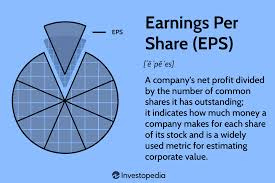Stock Buybacks: Confidence or Financial Engineering?
Unpacking Stock Buybacks: The Thin Line Between Confidence and Financial Engineering
Stock buybacks work well for cash rich companies. But there is always a determination to make. Is the action perpetrated by the confidence the company has in itself, or is it a way to financially engineer company results?
The EPS Equation: A Strategic Move or a Shortcut?
Earnings per share (EPS) is simple. A company's net profit is divided by its outstanding shares. Now imagine earnings are stagnant. What is the easiest way to increase EPS? Buyback shares to reduce the number of outstanding shares, the denominator. This can make the company appear more attractive to investors, but the underlying question remains: Is this a genuine strategy reflecting confidence, or a financial maneuver to mask stagnation?
Buybacks benefit shareholders by increasing their ownership stake. However, they also raise concerns about whether management is truly optimistic about long-term growth or merely seeking short-term stock price gains.
With such companies announcing huge buyback undertakings, like Apple (AAPL), this has come to mind. Apple, being cash-rich, likely sees this as a strategy to bolster short-term results. However, I believe this move also reflects management's confidence in the company's long-term prospects and its ability to sustain substantial cash flows. A slowdown in growth or growth opportunities might be one reason for a continued reliance on buybacks. For Apple, the integration of artificial intelligence into its products and services represents the next critical step. If this initiative falls short, it could prompt questions about the company's future growth trajectory. Until then, buybacks serve as a signal to investors that the company remains committed to its outlook and values shareholder confidence.
Apple: What is Trump Really Mad About?
It is highly improbable that Apple (AAPL) will relocate its large-scale production operations back to the U.S. The majority of iPhone production takes place in China, primarily through Foxconn (Hon Hai Precision Industry), Apple's largest manufacturing partner. About 70-80% of iPhones are assembled in China, benefiting from the country's extensive suppl…
Here’s a quick discussion taking on both sides of this argument:
Stock buybacks can be both, depending on the context. When a company repurchases its own shares, it might signal confidence—management believes the stock is undervalued and expects future growth, so they’re putting cash where their mouth is. It reduces outstanding shares, potentially boosting earnings per share (EPS) and making the stock look more attractive to investors. If the firm’s got excess cash and limited high-return investment opportunities, it’s a practical move to reward shareholders.
On the flip side, buybacks can be financial engineering dressed up as optimism. Some companies use them to juice EPS artificially, especially when growth is stagnant or executive bonuses are tied to that metric. They might borrow cheap debt to fund buybacks, masking weak fundamentals with a shiny stock price bump. It’s a short-term flex that can backfire if the cash could’ve been better spent on R&D, expansion, or weathering downturns—look at firms that gorged on buybacks pre-2008 only to beg for bailouts later.
Illustrative Examples
Confidence: Apple (2018-2024)
Apple’s a textbook case of buybacks signaling confidence. In May 2018, they announced a $100 billion buyback program, followed by a record-breaking $110 billion authorization in May 2024. At the time of the 2018 announcement, Apple was sitting on a cash pile of over $250 billion, with strong revenue from iPhones and services. The stock was trading at a P/E ratio of around 15, below the tech sector average, suggesting it was undervalued. Post-announcement, the stock jumped 4% in after-hours trading, and over the next few years, Apple’s share price more than tripled, hitting all-time highs by 2024. The buybacks reduced shares outstanding by about 25% since 2013, boosting EPS from $2.18 in 2013 to $6.13 in 2023, even as net income growth was solid but not explosive. This wasn’t just math—Apple’s consistent cash flow and innovation (think Apple Watch, AirPods) backed the move. Investors saw it as management betting on sustained growth, and the market rewarded it.
Financial Engineering: IBM (2000s-2010s)
IBM’s a classic counterexample where buybacks leaned toward financial engineering. From 2005 to 2014, IBM spent $108 billion on buybacks, reducing shares outstanding by over 30%. During this period, revenue growth was anemic—flatlining from $91 billion in 2011 to $92 billion in 2014—while EPS rose from $11.52 to $15.59. The catch? IBM funded much of this with debt, ballooning its long-term debt from $31 billion in 2010 to $61 billion by 2015. Instead of investing heavily in emerging fields like cloud computing, where rivals like Amazon and Microsoft gained ground, IBM leaned on buybacks to prop up EPS and stock price. The stock peaked at $206 in 2013 but crashed to $116 by 2018 as the lack of growth caught up. Critics, including analysts from Bernstein, pointed out that IBM’s buyback obsession masked stagnation—by 2020, its market cap was half of Microsoft’s, despite being neck-and-neck a decade earlier. Here, buybacks were less about confidence and more about papering over a fading business model.
The Real Question
The impact of stock buybacks is certainly debatable. However, whether it be confidence or financial engineering, an improved EPS is most likely to translate into higher stock prices over the long-term. Instead, you may need to ask yourself whether this was the best use of liquidity at that point in time for the company.
Think of it this way: A healthy company with strong cash flow and a low stock price signals confidence. On the other hand, a struggling firm accumulating debt to inflate EPS reflects financial engineering. The real story lies in the balance sheet, debt levels, and the areas where they’ve chosen not to invest—that’s where the underlying truth emerges.
Consider joining DiviStock Chronicles’ Referral Program for more neat rewards!Please refer to the details of the referral program.







